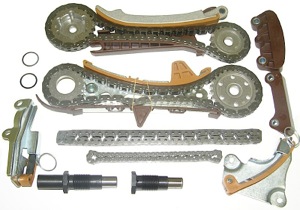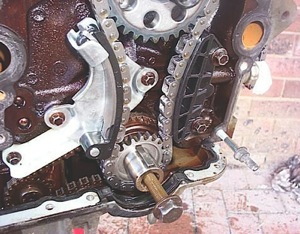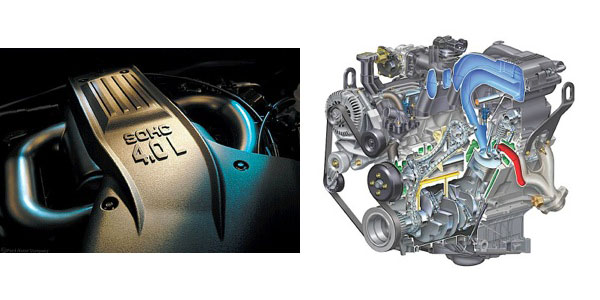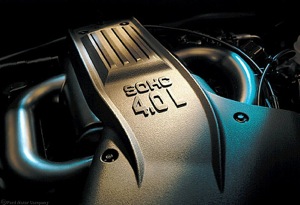Rated at a rather anemic 210 horsepower, the 4.0L SOHC V6 is not exactly a high output engine. It also has an unusual overhead cam drive setup. Unlike most other OHC V6 and V8 engines that drive both overhead cams directly from the crankshaft with a belt or chain, this engine has an intermediate jackshaft in the middle of the block where a pushrod cam would normally be located.
A short timing chain on the front of the engine connects the crankshaft to the intermediate jackshaft. A second, longer timing chain behind the first chain connects the front of the jackshaft to the overhead cam on the left side of the engine.
A third timing chain in the back of the engine connects the rear of the jackshaft to the overhead cam in the right cylinder head. There is also a balance shaft in the crankcase of engines used in 4×4 trucks, which is driven by a fourth chain directly off the crankshaft.
Why Ford designed the cam drives this way is anyone’s guess. It probably allowed the engine to be shorter and more compact. But one of the unintended consequences of this fore-and-aft split cam drive arrangement is that it makes the timing chains, guides and tensioners VERY difficult to replace — which makes for an expensive repair when a chain guide or tensioner fails on one of these engines (a common problem on high mileage engines, especially if the owner has neglected regular oil changes).
Timing Chain Problems
Some of the early engines up through 2002 in the Ranger and Explorer have had a timing chain rattle problem due to the poor design of the original Teflon chain guides. The noise is most noticeable when a cold engine is first started, and is usually loudest from 2,400 to 3,000 rpm.
The same noise problem can also develop in 2003 and newer high-mileage engines as a result of chain guide wear. In some instances, the guide may break and disintegrate and spew debris into the oil pan. This may also cause one of the timing chains to break (typically the front left chain).

Fortunately, the 4.0L SOHC is not an interference engine so a timing chain failure won’t bend the valves. But it does create an expensive repair for the vehicle owner.
Ford issued a TSB for the timing rattle problem and released a redesigned “‘cassette”‘ (the timing chain, gears, guide and tensioner assembly) for the left front timing chain. This timing chain cassette can be replaced without having to pull the engine out of the vehicle.
But, if the engine has a bad rear chain or guide, or a chain guide has failed and throws debris into the crankcase, you will have to remove the engine to make the required repairs. That includes removing the flywheel and flexplate so that the rear cam drive cassette can be replaced, and pulling the oil pan so any debris in the oil pan and oil pickup screen can be cleaned out.
You’ll also need a special tool kit (Ford or aftermarket) to hold the cams and tension the timing chains, and to prevent the crankshaft from rotating while you’re doing the cam drives. You’ll also need the proper puller to get the harmonic balancer off the crankshaft.
The redesigned Ford primary timing chain service kit includes an improved chain tensioner and chain guide, chain, jackshaft and sprockets. Kit number 2U3Z-6D256-AA is for balance shaft engines in 1999 to 2001 4×4 Explorer/Mountaineer, 2001 to 2002 4×4 Sport/Sport Trac and all 2002 Explorer/Mountaineer (except engine codes 2G-960-AA and 2G-964-AA). Kit number 2U3Z-6D256-BA is for non-balance shaft engines in 1999 to 2001 2WD Explorer/Mountaineer and 2001 to 2002 2WD Sport/Sport Trac, and all 2001 to 2002 Ranger.
Engine Service
If the head gasket is leaking, replacing the left head gasket can be done with the engine in the vehicle (assuming there is enough room to pull the head). But if the right head has to come off, the only way to remove the head is with the engine out of the vehicle because of the rear cam drive on the right head.
At this point, some might argue that it’s cheaper and easier to simply find a good used engine and replace the old motor rather than repair it. This might be a viable alternative IF you can find a good used low-mileage 4.0L SOHC V6 that can be swapped into your customer’s vehicle.

But by the time many of these engines end up in a salvage yard, they don’t have a lot of miles left in them. A better option if your customer is willing to spend the money would be to install a remanufactured engine. A reman engine from a reputable supplier should be completely reconditioned to original specifications and come with an extended warranty.
Some suppliers offer a three-year or 36,000-mile warranty with their reman engines. That’s a better deal than the 30 day guarantee many salvage yards offer (which doesn’t include labor!).
If the engine in your customer’s vehicle has a timing chain rattle problem, and the engine has less than 100,000 miles on it, doing an oil change and using a light viscosity, pure synthetic oil can sometimes quiet the noise.
The lighter oil will flow to the timing chain more quickly following a cold start and reduce the noise somewhat. However, if the engine has a lot of miles on it (more than 100,000) or changing motor oils makes no difference, replacing the timing chain cassette(s) will likely be necessary to quiet the engine.
As we mentioned earlier, this is a rather involved repair procedure so always refer to the Ford service literature for the step-by-step details. If you try to wing it as you go, you’ll likely be in for some unpleasant surprises along the way.
The jackshaft drive gear and cam drive gear retaining bolts are TTY (torque-to-yield) and should not be reused. If you don’t replace these bolts with new ones, there’s a risk of breakage. The rear jackshaft bolt is also covered by a small circular plug on the back of the engine. It looks like a freeze plug but isn’t.
The front left chain tensioner can be tricky to extract because of its close proximity to the thermostat housing and coolant sensors. You may have to remove the thermostat housing if you can’t get the tensioner out with a wrench or deep socket.
The left (front) and right (rear) cam drive cassettes for this engine are different, and the design and quality of the parts can vary depending on the supplier. Some aftermarket suppliers buy their cam drive cassettes from the same original equipment supplier that Ford uses, while others do not. Since this is a labor-intensive repair that should only have to be done once, don’t try to save money on a no-name part. Go with the genuine Ford replacement parts or parts from a quality-brand aftermarket company.
Other “fun” parts to replace on this engine include the heated PCV valve on the back of the left valve cover. It’s out of sight and hard to reach with little clearance between the engine and firewall.
Diagnostics
If the Check Engine light is on and you’re doing misfire diagnostics on a 2006 and up Explorer, a new scan tool PID that’s available on these models is the actual burn time of each individual spark plug. By comparing the spark durations, you can quickly see if a spark plug is fouled or a cylinder has low compression because the burn time for that cylinder will be longer. If you see a cylinder with a shorter burn time, it would tell you that cylinder is running lean or the spark plug gap in that cylinder is worn or set too wide.
On some 2005-’10 Mustangs with automatic transmissions, there can be an annoying vibration at idle, especially when the A/C is on. The problem is not the engine, but an exhaust vibration. Ford TSB 05-8-6 says the cure is to install a damper kit to dampen the annoying vibration. The kit is P/N 5R3Z-5F240-A.
Maintenance Recommendations
The original equipment spark plugs are platinum with a 100,000-mile service interval. Make sure you install the correct replacement plugs because the ones for the 4.0L OHV pushrod engine are shorter and won’t position the electrode the correct distance into the combustion chamber.
Though Ford diehards tend to stick with the original Motorcraft brand spark plugs, any brand of spark plug will work in these engines provided the plug manufacturer has a listing for the engine application. The plug gap is 0.054” on most applications.
The crankcase oil capacity on the 4.0L SOHC V6 is 5 quarts, usually 5W-30 for the older vehicles and 5W-20 for the newer ones. Refer to the vehicle owner’s manual for the recommended viscosity.















